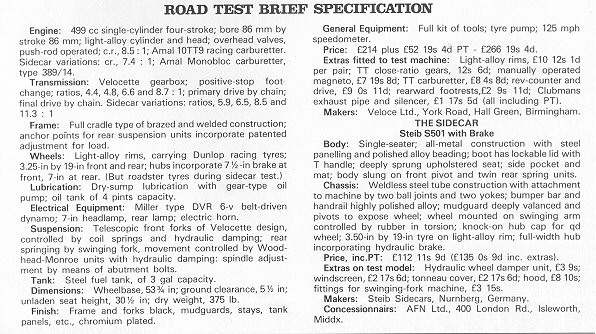
^ Back to Home Page ^
Period Roadtests
o

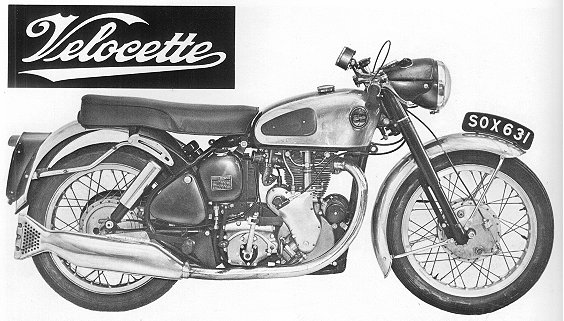
| IT is many years since it
was first suggested by some sections of the motorcycling public that
"the single is dead." After riding the 500 cc Velocette "Venom" anyone
could be forgiven for thinking that the converse could come to pass,
for its lusty single-cylinder unit, in the matter of vibration-free
power, is fully capable of making its presence known amongst its
multi-cylinder rivals of equal, or even greater, capacity.
In the form tested the machine was in what is generally known as "Clubman's" trim, having a host of optional extras, including light-alloy wheel rims, manually controlled BT-H magneto, Amal TT-type carburettor, rev counter, rearward-mounted footrests, special exhaust pipe and silencer and extra-close "TT" gear ratios. With the extra power available it proved completely practical to pull a top gear of 4.4:1, obtained by fitting a gearbox sprocket having 20 instead of a standard 18, teeth. Bottom gear on this set-up was 8.7:1 - decidedly high but by no means impractical. When driving in town traffic the clutch could be gently fed in and, once under way, upward changes made at engine speeds of about 2,500 rpm. In top the model would "plonk" along quite happily on a whiff of gas on about 2,000 rpm. The exhaust pipe and carburettor tended to "fight" at 2,900-3,100 rpm with some consequent eight-stroking but it was easy to drive straight through this extremely narrow band. Once over that rate of rpm the power came in steadily up to the peak figure of just over 6,000 rpm. Town progress at the 2,000-rpm mark was of the order known as "gentlemanly," with a steady, dull beat coming from the silencer and only the faintest of mechanical taps - a trace of slap from the sports-type piston - from the engine. No noticeable noise came from tappets, timing gears or gearbox at any speed or in any gear. |
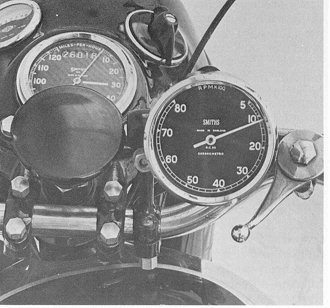
| but the "Venom" deserves a gayer life than plodding in town - that is a job best left to its more docile stablemate, the MSS tourer. It is a machine that longs for the open road and an early morning traffic-free run. Once clear of houses and their accompanying restrictions the bike could be used as it cries to be used. From a standing start a sizzling getaway was easy if the revs were turned up, held on, and the clutch fed home. Given this treatment the model was doing 30 mph before the clutch was properly home - and 55 very soon afterwards. The lightest of dabs on the gear pedal into second, with a momentary easing of the throttle and clutch, gave the rider a "bonk on the back" which definitely left its impression and the "Venom" really had the bit in its teeth. Another change, at just over "70," brought third gear into play - and what a gear! At 4.8:1 it is higher than most "500's" pull for top! If the road was clear, this gear really whistled the machine along, up to within easy striking distance of the "ton" when a last change, into top, took the model and the rider over the barrier with an ease never expected of a docile-at-low-speeds half-litre. Speed counts for a lot with a mount of this calibre, but it is no good going fast without the requisite safety measures. At the 100 mph mark the "Venom" felt as steady as the oft-mentioned rock; not even a trace of steering damper was used and, as is now expected from the factory that built the Mk. VIII KTT, not a vestige of deviation from the chosen path. |

|
Braking from very high velocities was outstandingly good and, unfortunately, the figures from 30 mph shown on the accompanying graph, although up to scratch, do less than justice to the really first-class stoppers. There was never any suspicion of fade, no squealing - just very good braking, especially from the front anchor. When the speed had dropped considerably it was necessary to ease pressure on the rear pedal, otherwise there was a tendency for the back wheel to lock. If it was accidentally locked the machine did not get out of hand, although the noise from the tire brought the riders immediate attention to the situation! Establishing a true maximum-speed figure for a model capable of almost two-miles-a-minute progress is never easy and to obtain a proper assessment of the "Venom" recourse was made to the excellent test facilities of the MIRA (Motor Industries Research Association) proving ground at Lindley, near Nuneaton. Here two-way runs through electronically timed portions of the track produced a top-speed figure that is absolutely accurate. Despite repeated screaming from 0 to 100 mph, the motor remained oil-tight, the exhaust pipe did not even become straw-coloured, and the maximum figures remained consistent at about 108 mph in one direction and 103 mph in the other. After no fewer than 20 runs shared between two riders the clutch began to protest a little. The tester adjourned for an hour's lunch break and then repeated proceedings, using a 21-tooth gearbox sprocket, which hoisted the gear to 4.2:1! This did not produce any noticeable increase in speed on the timing strip, but on the high-speed circuit the top speed was recorded as 110.6 and 110.3 mph on consecutive runs with laps at 103-104 mph; unfortunately, it is a one-way circuit so a mean could not be taken. It was decided to fit the 20-tooth sprocket to get the slightly better acceleration figures for the graph. |
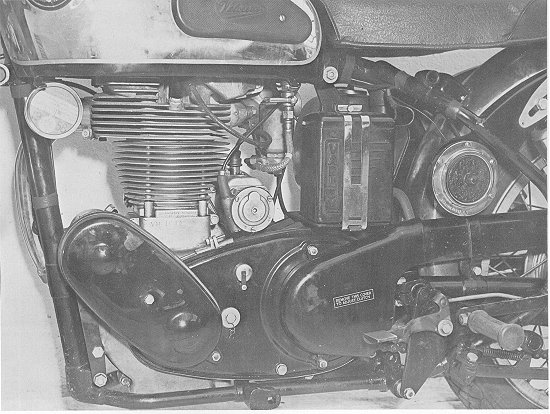
|
Mention must be made of the ease with which the gear-ratio swapping
operation can be carried out. Readers may recall that the Velocette
single-cylinder range employs a very narrow crankcase, with the
consequential immensely stiff crankshaft assembly. This gives a narrow
chain line, permitting the clutch to be carried inboard of the
rear-driving sprocket. This has the resulting advantage that the
sprocket can be changed in about a couple of minutes, with only three
nuts to undo, plus rear-chain adjustment afterwards.
Rev-counter squint Several points came to light during the MIRA visit; the "standard" handlebar bend, inverted for the lower riding position, could advantageously have been narrower. The speedometer could not be seen from a flat-on-the-tank position, and the rev counter was a little too near to the rider's eye for comfortable viewing; a line to indicate maximum revs would have been a boon. The foot controls were spot-on for a crouched riding position, but a shade awkward to operate when sitting up. After the MIRA test the "Venom" was used in London's traffic, plus weekend reporting trips, with the bars reversed to their standard position. This proved better for all practical purposes and less tiring on long runs. Maintenance of the machine is simplified by the provision of a first-class tool kit, but it was found that the sparking plug is awkward to get at without burning one's fingers! The rear suspension is easily adjustable for load without restricting the range of movement of the units; it was kept in the softest position for the speed tests but for fast roadwork it was found that the best results were obtained with the springing stiffened up. With the suspension adjusted to taste, bend-swinging could be enjoyed to the full, the model clinging to the set line in exemplary fashion. The front forks dealt adequately with all bumps, large or small, with the back-end springing matching-up in perfect harmony. Speed was at all times dictated by road conditions and never by the power output of the motor. At night fast cruising would have been more enjoyable with a main headlamp beam of greater intensity. Better than JAP twostrokes |
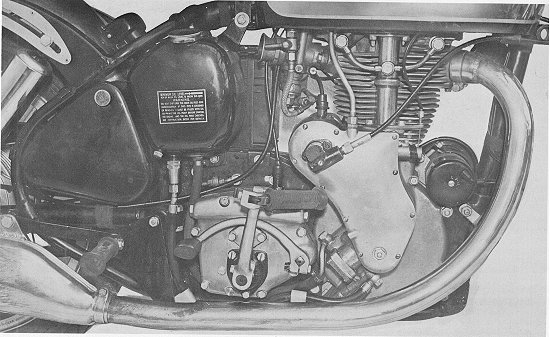
| Used in the manner in which it should be used - for fast cruising on
open roads - the "Venom's" consumption worked out a 48 mpg overall, and
every one of those miles was a memorable one!
In the trim tested, the machine costs, with Purchase Tax, 307 Pounds 16s 6d; this is a good deal of money, but it is doubtful if any machine could inspire more pride of ownership. With its finish of chrome and black, with gold lining, the "Venom" is a very attractive motorcycle, possessing a character of refinement that stems from noble breeding. "GENTLEMANY roadburner," would be a fair description of the Velocette "Venom" / Steib S501 outfit which forms the subject of this report. During the test period, the outfit covered well over a thousand miles of mainly full-bore work, plus almost as much town running, and the only involuntary stop occurred when the front wheel picked up a nail - a stroke of fate for which the machine could not be blamed. Both bike and sidecar earned top marks under most headings, and the outfit's stay on test strength, which was much longer than that for the majority of machines, was itself indicative of the affection which it earned from staffmen. The "Venom" is a logical development of the MSS 500 cc single-cylinder machine, which has been a firm favourite for many years. Main changes from that model, apart from the lavishly-chromed "sports" finish, are in the tuned power-unit with modified valve timing and compression ratio, which give some 36 bhp at 6,300 rpm. Unfortunately the standard "Venom" compression ratio of 8:1 proved too high for sidecar work and had to be reduced to some 7.4:1. This meant a slight loss in maximum power but resulted in a much more tractable outfit. Use of the standard compression ratio had resulted in extensive pinking even on 100-octane fuel, but the test model, after modification, pinked under only harsh driving conditions and premium fuel and not at all on 100-octane. A ready start from cold could be obtained provided care was taken to retard the manual ignition control (an optional extra), close the air lever, and follow the standard Velocette drill of "find compression, squeeze the valve lifter and depress the kick-start lever to the bottom of its travel, allow it to return to the top and then, after releasing the valve lifter, give a steady kick." This business sounds complex but in practice takes only seconds. The engine usually responded after a couple of kicks; if the ignition had not been retarded it would kick back really hard, as was to be expected of a sporting single! The carburettor was situated so close to the tank that only a driver with small hands could reach the tickler. The standard KLG FE100 plug was changed for a "hard" FE260 type for the speed tests. This was left in situ afterwards and the engine could always be started from cold without any appreciable difference. With the hard plug, however, there was a noticeable increase in "muttering" in the exhaust system on the overrun. Once the engine had fired, the air lever could be opened fully and forgotten. "Hot" starting involved no more than retarding the spark and giving a single kick. Engagement of bottom gear from rest was spot-on; the clutch freed easily, was exceptionally light in operation and needed no adjustment throughout the whole test. When the speed figures were being taken, necessitating much clutch abuse, the linings swelled after two standing "quarters," giving excess cable clearance, but they returned to normal after a short stop. This trouble never occurred in normal use, even in vile traffic conditions. Machineshop economies |
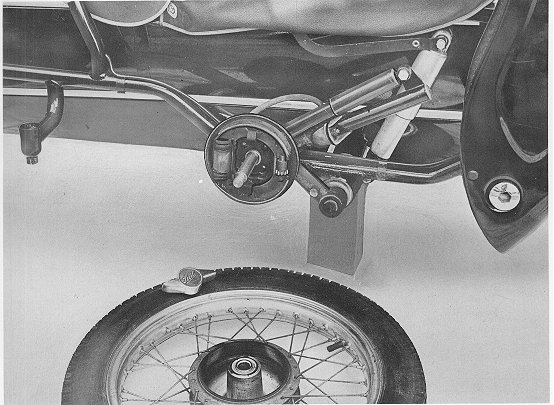
|
Once under way, the gear change proved first-class. The change lever has
a square hole, which fits into a square shaft; adjustment was neither
possible nor necessary. The TT close ratios on the test outfit were an
optional extra; it seemed doubtful whether they provided any advantage
over the standard ratios except for fast main-road work, when the very
close third proved useful for hill-climbing at 60-plus mph! In
conjunction with the close gears, a 15-tooth final-drive sprocket was
substituted for the normally recommended 16 t. This allowed the engine
to rev more and gave a slight increase - about 2 mph - in top speed;
with a higher cogging, the outfit had been quicker in third than top.
Quick away from rest.
Town work brought out the gentlemanly aspects of the outfit. Tickover was regular, acceleration from nil was superb - causing consternation to London taxi-drivers - and braking was also good. The outfit's handling in town, with or without a passenger, made even hardened testers enthusiastic, although one had to become accustomed to the exceptionally "taut" and trim feel. Tight corners to right or left produced no trace at all of chassis flexing. A steering damper, fitted as standard, proved completely ornamental; indeed the outfit is the first tried for many years which the damper has not been needed. Not even a trace was used from 0 to maximum speed. If the damper was screwed down it could immediately be felt, as is the case with a solo. No hands, no-damper driving was possible at 25 mph. Taut and driftable Open-road work revealed the road-burning potentialities of the outfit. The zestful acceleration through the gears left nothing to be desired and, with the instantaneous response of the motor to the throttle, converted "bar-side averages" into realities. It proved possible to drift the outfit through fast bends to either right or left with very little effort, it stayed on line and demanded no particular technique. Sidecar lifting could only be provoked by bad driving with an empty chair and by even worst driving with a passenger aboard. The alignment of the outfit proved perfect; there was a slight pull to the left on full power and to the right on the overrun (without braking), an ideal set-up giving complete freedom from muscular fatigue. |

|
Constant full-throttle driving on open roads for long distances did not
perturb the engine, in fact it had about it in "indestructible" feeling
which has been confirmed in long-term experience of an identical
machine used by a staffman as personal transport. Some engine vibration
could be detected, but it did not become obtrusive at any speed. At
night it was found that full-throttle work on long hills caused the
exhaust pipe to glow; apart from discolouring the pipe for many inches
it had no other effect.
The test machine developed some oil leaks on the power unit; these did not appear until a large number of full-throttle miles had been covered. If the oil tank were filled to within 1.5 in of the filler orifice or higher - no level was marked - the rear of the machine would be liberally bathed in oil from the tank breather. Although the braking figures from 30 mph were not exceptional, they were good; but they do not convey the full picture, for hard use of the brakes from speeds in the 70 mph region produces no trace of fade and the only attention required during the long test was a couple of turns of the rear brake adjuster. The hydraulic sidecar brake gained top marks, being noticeably better than the machine's rear brake. With the two brakes set to give an even pull-up when used together - ie the "chair" brake having a slight lead - it was found that the rear brake locked before the sidecar brake. This was especially noticeable on wet roads. The electrics on the test machine came in for some criticism. The ammeter disintegrated internally and had to be by-passed; the dynamo brushes had to be renewed as they had worn down, and the pilot light contact proved intermittent despite attention. Standard equipment of a "Venom" includes a stop-lamp, but the switch had to be removed to allow the master cylinder for the hydraulic brake to be fitted. It was noticed the plug-changing with a hot engine demanded either care or burn lotion. The headlamp beam was not really adequate for high-speed night cruising. A speedometer error of 8 per cent fast was noted up to 55 mph falling to 7 per cent at 70 mph. The graph figures were taken with the screen and hood erected. With these items stowed and a tonneau cover fitted, the maximum speed went to within 0.75 mph of "70" on a dead-level road in still air. It must be recorded that the smallest point in favour of the model - either a slight down-grade or a slight following wind - let the maximum soar up to the 75 mph region; on several occasions the build-up of speed on a down-grade was held on the level. All test figures were obtained with the 15 t sprocket fitted. The engine's fundamental ability to rev and to rev continuously without any rider discomfort, coupled with the fade-free brakes, excellent handling and instantaneous response to the throttle, gave the outfit a distinct advantage over some with larger engines which tended to tire their rider on long runs. That lusty Velo sound |
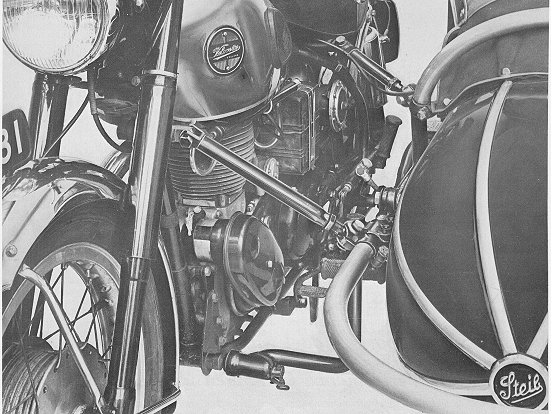
| Passenger comments upon the sidecar were generally good. Of sports-sidecar standards, comfort is of a high order, with road shocks, large or small, well ironed out. The low position of the "chair" in relation to the bike caused some discomforts on long runs because of the exhaust note - on full throttle the "Venom" sings a tune which is definitely on the "lusty" side. The hood was given top marks for the way in which it cleared the head even of a 6-ft passenger, but it proved so tiresome to fold and stow in the separate cover provided that it was kept erected for most of the test. It was not 100 per cent draughtproof, but completely waterproof. The external, locking, "Tee" handle of the boot was convenient; the amount of room in the boot was reasonable for a sports sidecar and the sheathed check-straps on the lid were appreciated. A substantial mat is provided under the passenger's feet. Unfortunately it was necessary to stand on the seat when entering or leaving the sidecar - a feature common to most sporting "chairs" and one which is, generally speaking, difficult to overcome. Steib facilities |
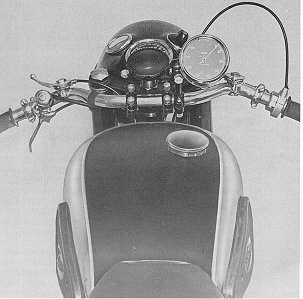
|
A mudguard which is streamlined, can be quickly lifted to expose the
wheel, built-in grab-rail-cum-lamp adding considerably to the outfit's
appeal, both functionally and aesthetically. A quickly detachable
sidecar wheel with knock-on cap and light alloy in standard; the alloy
rims on the machine are "extra." Standard "Venom" equipment,
incidentally, includes an excellent tool-kit. To sum up, this is an outfit for the discerning rider. Both the "Venom" and the Steib are quality products and, consequently, are not cheap. In return for a total inclusive cost of some 400 pounds one gets one of the most zestful vehicles on the roads of this country - one with which older men can recapture their youth and yet have a model in keeping with their experience, and with which any youngster fortunate enough to be able to buy it must make himself the envy of his confederates. As a piece of offering to our staff, Veloce Ltd. Have agreed to let Motor Cycling have the "Venom" for test in solo trim, to full clubman specification, in the next month or so - providing we can tear ourselves away from it while the conversation takes place. |
